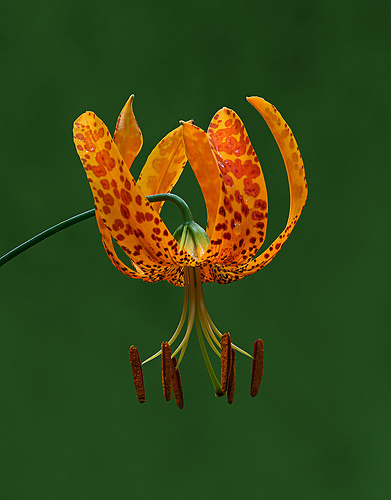Below is an article released by the cooperative extension service of the University of KY. The information is new for KY residents and maybe helpful to other states where the Emerald Ash Borer already exists, or for places where it may migrate this season.
If you suspect EAB infestation, you might consider using Monty’s products as part of a treatment program. You can see a description of that treatment program here. While we have no definitive evidence that this program will help with EAB control, our program has shown success in ID in control of Pine Bark Beetles and would tend to indicate at least some help may be available in preventing outbreaks on your property.
LEXINGTON, Ky., (Feb. 24, 2010) – In 2009, the emerald ash borer

Macro image of Kentucky's newest resident, the Emerald Ash Borer
turned up in Kentucky. Bluegrass state residents knew they probably couldn’t dodge the bullet forever but still hoped to keep the devastating insect pest at bay for as long as possible.
“Now that the EAB is in Kentucky, it’s likely here to stay,” said Amy Fulcher, University of Kentucky College of Agriculture extension associate for nursery crops. “Entomologists anticipate that seedling ash trees in unmaintained areas in and near infested urban areas will sustain EAB populations.”
So with the emerald ash borer a seemingly permanent resident, Kentuckians must decide how to care for ash trees in home landscapes and municipalities. Fulcher and UK Consumer Horticulture Specialist Rick Durham believe that residents and city planners can help maintain healthy urban forests by removing ash trees and replacing them with other species or treating their existing trees to control the insect.
“It’s not too early to begin considering which strategy to pursue,” Durham said.
Durham said that landscape contractors and arborists often provide ash removal and replacement as well as emerald ash borer treatment services for preserving ash trees.
“You have to consider many factors before choosing an EAB management strategy,” he said. “The health, location and size of the ash tree will have an impact on the value of the tree. A tree with mower or trimmer damage, existing pest damage, poor location (under power lines or too close to a structure), poor planting (too deep, nylon twine intact), previous topping, or dieback or other defects would be less valued than a tree with proper placement and healthy roots, trunk and branches.”
Fulcher added that a tree in poor health would be less able to take up the pesticide and thus, tree health will impact treatment success.
“Sentimental value, tree size, presence of other tree species and significance of an ash tree can also impact the value of the tree and will vary from person to person,” she said.

Ash Borer chambers just under the bark of an infected tree
Fulcher said trees larger than 22 inches in diameter often cannot take up sufficient quantities of pesticide to adequately protect the tree, although future products may make that possible.
“Large trees are expensive to remove and replace but also the most costly to protect,” she said. “Small ash trees are less expensive than larger trees to remove and replace but also the least expensive to treat. Because a small tree can be removed and replaced relatively inexpensively and eliminate the need for protracted EAB treatments, small trees are ideal candidates for removal and replacement.”
Durham said homeowners and landscapers can purchase replacement trees relatively inexpensively.
“The weak housing market and generally poor economy have led to decreased trees sales and, as a consequence, prices have substantially dropped,” he said. “These savings at the wholesale price level are often passed down to the consumer, which means homeowners are having an unprecedented opportunity to purchase trees inexpensively.”
Once a homeowner or landscaper makes the decision to replace an ash tree, it’s often difficult to choose what species will take its place. Fulcher emphasized that while it may seem easy to suggest a list of trees for possible replacement, landscapers should take care to ensure the replacement tree is right for the individual site.
“A local arborist or nursery professional can help you make this decision,” Fulcher said. “Some things to consider include the potential mature height of the tree being planted, particular soil conditions (wet, dry, alkaline, heavy clay), whether or not you hope to grow grass under the tree, desired fall foliage color, or desired spring flowers.”
Fulcher recommended landscapers also consider whether the selected replacement has resistance to particular pests and keep in mind that the selection must be adapted for Kentucky’s climate.
If the tree produces fruit, such as crabapples, consider whether it is a good match for the site. Crabapples planted near sidewalks and driveways may result in slippery surfaces once fruit begin to fall, she said. A brochure that lists acceptable street trees for Lexington can be found by entering the term “street tree” at http://www.lexingtonky.gov. City or county governments may have similar information available.
“When considering management strategies, be sure to ask for a Certified Arborist or a Kentucky Certified Nurseryman,” Durham added. “Ask about how the treatment will be applied, by drenching or injecting the tree; the consequences of each application technique and how long the pesticide application is expected to last. And, if your new replacement tree was grown in Kentucky, ask for the Kentucky Proud logo.”
Fulcher and Durham stressed that people need to remember not to move firewood that comes from ash trees. The Kentucky Nursery Inspectors emerald ash borer Web site http://www.pest.ca.uky.edu/ext/EAB/welcome.htmland UK Department of Entomology’s publication, Entfact 453, viewable at http://www.ca.uky.edu/entomology/entfacts/ef453.asp, are excellent resources that address quarantine and other issues. Additional information prepared by a university-based consortium of states affected by emerald ash borer is available at http://www.emeraldashborer.info/index.cfm. Find information on native Kentucky trees that can be used as ash replacements at http://www.uky.edu/Ag/Horticulture/kytreewebsite/.
-30 –
 Share on Facebook
Share on Facebook


 s on this plane.
s on this plane.





